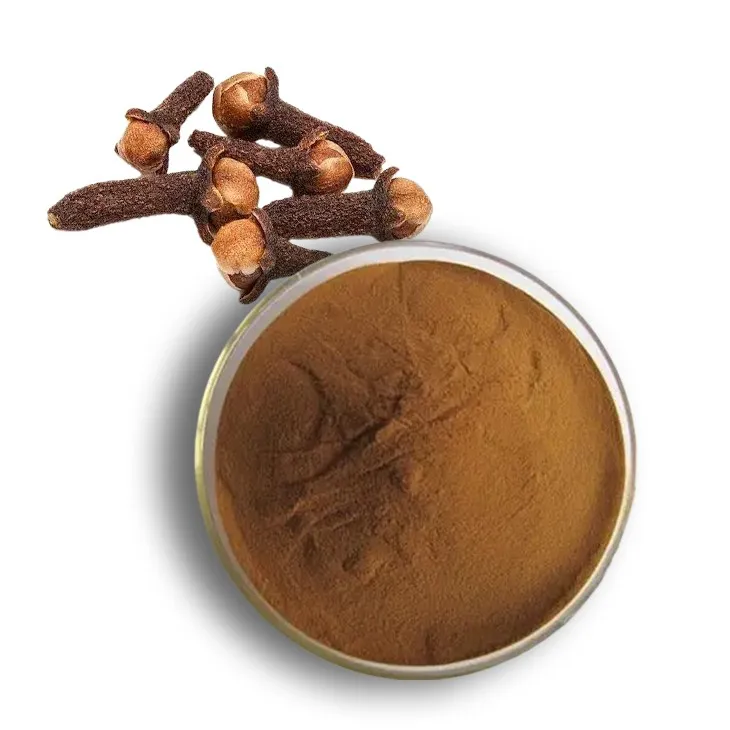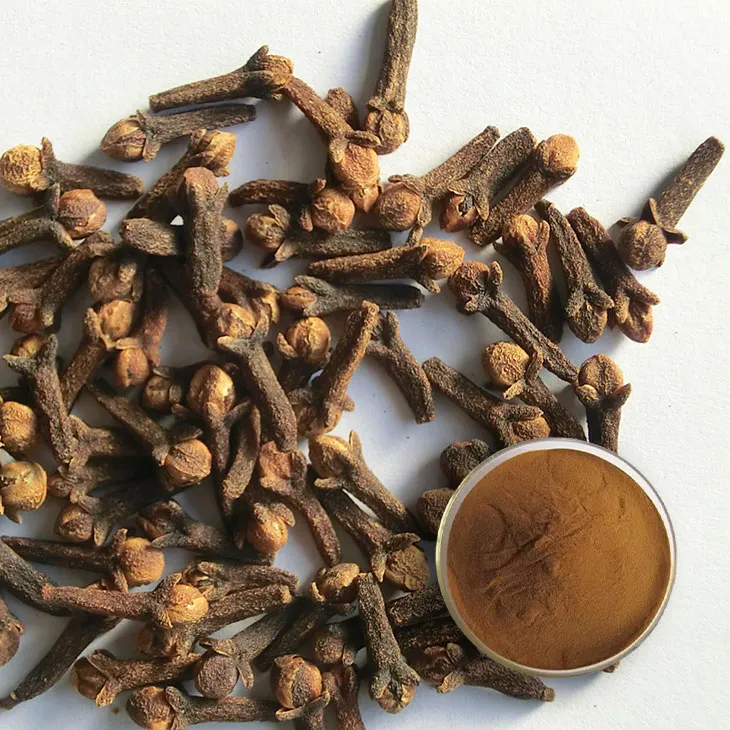- 0086-571-85302990
- sales@greenskybio.com
The process of extracting eugenol - like compounds from clove powder.
2024-11-26

1. Introduction
Clove Powder is a well - known natural product that contains valuable eugenol - like compounds. These compounds have various applications in the fields of medicine, food, and cosmetics due to their unique chemical properties. Extracting eugenol - like compounds from Clove Powder is thus of great importance for both scientific research and industrial production.

2. Chemical properties of eugenol - like compounds
Eugenol is the main component among eugenol - like compounds in Clove Powder. It has a characteristic phenolic odor and is a colorless to pale yellow liquid. Chemically, eugenol is an allyl chain - substituted guaiacol. It contains a phenolic hydroxyl group (- OH), which gives it certain acidity and reactivity. This hydroxyl group can form hydrogen bonds, which is related to its solubility and extraction behavior.
Other eugenol - like compounds in clove powder may have similar chemical structures with minor differences in functional groups or side chains. These differences can lead to variations in their physical and chemical properties such as boiling point, solubility, and reactivity.

3. Traditional extraction techniques
3.1. Steam distillation
- First, the clove powder is placed in a distillation apparatus. The powder should be evenly spread to ensure good heat transfer.
- Steam is then introduced into the apparatus. The steam heats the clove powder, causing the eugenol - like compounds to vaporize due to their relatively high volatility.
- The vapor mixture of steam and eugenol - like compounds is then condensed in a condenser. As the vapor cools, it turns back into a liquid phase.
- Finally, the condensed liquid is collected. Since eugenol - like compounds are immiscible with water to a certain extent, they can be separated from water by using a separating funnel.
Disadvantages: The yield of this method may not be very high, and the purity of the extracted eugenol - like compounds may be affected by other volatile substances in the clove powder.
3.2. Solvent extraction
- Select an appropriate solvent. Commonly used solvents include ethanol, hexane, etc. The choice of solvent depends on the solubility of eugenol - like compounds.
- The clove powder is soaked in the solvent for a certain period of time. This allows the eugenol - like compounds to dissolve into the solvent.
- After soaking, the mixture is filtered to remove the solid residue of the clove powder.
- The solvent containing the eugenol - like compounds is then evaporated, either under reduced pressure or at normal pressure, to obtain the concentrated eugenol - like compounds.
Disadvantages: The solvent may be toxic or flammable, which requires special handling and safety precautions. Moreover, the residual solvent in the final product may affect its quality.

4. Modern extraction techniques
4.1. Supercritical fluid extraction
- Carbon dioxide (CO₂) is often used as the supercritical fluid. First, CO₂ is pressurized and heated to reach its supercritical state. In the supercritical state, CO₂ has properties between a gas and a liquid, such as high diffusivity and low viscosity.
- The supercritical CO₂ is then passed through the clove powder. The eugenol - like compounds are selectively dissolved in the supercritical CO₂ due to their solubility in this fluid.
- By changing the pressure and temperature conditions, the solubility of eugenol - like compounds in supercritical CO₂ can be adjusted, which allows for the separation and purification of the compounds.
- Finally, the supercritical CO₂ is depressurized, and the eugenol - like compounds are obtained as a separate phase.
Disadvantages: The equipment for supercritical fluid extraction is relatively expensive, which limits its widespread application in some small - scale or low - budget operations.
4.2. Microwave - assisted extraction
- The clove powder and the extraction solvent (if any) are placed in a microwave - transparent container.
- The mixture is then irradiated with microwaves. The microwaves cause rapid heating of the sample due to the interaction between the electromagnetic field and the polar molecules in the sample. This rapid heating can enhance the extraction efficiency as it promotes the mass transfer of eugenol - like compounds from the solid clove powder to the solvent (if used) or into the vapor phase (in case of steam - like extraction).
- After the microwave irradiation, the extraction product can be separated and purified using the same methods as in traditional extraction techniques, such as filtration and evaporation.
Disadvantages: The distribution of microwave energy may not be completely uniform, which may lead to inconsistent extraction results in different parts of the sample.
5. Comparison of yields and purities
- Steam distillation: As mentioned before, the yield of steam distillation is relatively low, usually in the range of 10 - 15% depending on the quality of the clove powder. The purity of the obtained eugenol - like compounds is also relatively low, as other volatile substances may be co - distilled. For example, some terpenes in the clove powder may be distilled together with eugenol, reducing the overall purity.
- Solvent extraction: The yield of solvent extraction can be relatively high, up to 20 - 30% depending on the solvent and extraction conditions. However, the purity may be affected by the residual solvent. If the solvent removal process is not complete, the presence of the solvent in the final product can lower the purity. For example, if ethanol is used as the solvent and not completely evaporated, it will be present in the eugenol - like compound product.
- Supercritical fluid extraction: This method can achieve a high yield, often exceeding 30% in optimal conditions. Moreover, the purity of the extracted eugenol - like compounds can be very high, as the selectivity of supercritical CO₂ can effectively separate eugenol - like compounds from other impurities in the clove powder.
- Microwave - assisted extraction: The yield of microwave - assisted extraction is comparable to that of solvent extraction, typically in the range of 20 - 30%. The purity can also be relatively high if the extraction process is well - controlled, as the rapid heating can help to break down the cell walls of the clove powder more effectively, releasing the eugenol - like compounds with less contamination from other substances.
6. Conclusion
The extraction of eugenol - like compounds from clove powder is a complex process with various techniques available. Traditional techniques such as steam distillation and solvent extraction have their own advantages and disadvantages in terms of yield and purity. Modern techniques like supercritical fluid extraction and microwave - assisted extraction offer new possibilities for more efficient and high - quality extraction. Researchers, students, and industry professionals need to consider the specific requirements, cost, and scale of their projects when choosing an extraction method. Overall, the continuous development of extraction techniques will contribute to the better utilization of eugenol - like compounds from clove powder in various fields.
FAQ:
What are the main traditional extraction techniques for eugenol - like compounds from clove powder?
One of the main traditional extraction techniques is steam distillation. In this method, steam is passed through the clove powder. The heat causes the eugenol - like compounds to vaporize along with the steam. Then, the vapor is condensed back into a liquid, and the eugenol - like compounds can be separated. Another traditional method is solvent extraction. Organic solvents such as ethanol are used to dissolve the eugenol - like compounds from the clove powder. After that, the solvent is evaporated to obtain the desired compounds.
What are the modern extraction techniques for eugenol - like compounds from clove powder?
Modern extraction techniques include supercritical fluid extraction (SFE). In SFE, supercritical carbon dioxide is often used as the extraction solvent. It has the advantages of being non - toxic, having a low critical temperature, and being easy to remove after extraction. Microwave - assisted extraction (MAE) is also a modern technique. Microwave energy is used to heat the clove powder and the solvent, which speeds up the extraction process by enhancing mass transfer and increasing the solubility of the eugenol - like compounds.
How do the yields of traditional and modern extraction techniques compare?
Traditional extraction techniques like steam distillation may have relatively lower yields compared to some modern techniques. Steam distillation may not be able to extract all of the eugenol - like compounds efficiently due to factors such as incomplete vaporization. Solvent extraction can have a moderate yield but may also have issues with solvent residues. Modern techniques such as supercritical fluid extraction often have higher yields. It can better access and extract the eugenol - like compounds from the clove powder matrix. Microwave - assisted extraction can also increase the yield by improving the extraction efficiency in a shorter time.
How are the purities of eugenol - like compounds obtained by different extraction techniques?
With traditional steam distillation, the purity of the obtained eugenol - like compounds can be relatively high as long as proper separation steps are followed after condensation. However, solvent extraction may introduce some impurities from the solvent itself if the solvent removal process is not complete. Modern techniques like supercritical fluid extraction can often achieve high purities because of the selectivity of the supercritical fluid. Microwave - assisted extraction may require additional purification steps depending on the nature of the clove powder and the extraction conditions, but it can also produce relatively pure eugenol - like compounds.
What are the important chemical properties of eugenol - like compounds relevant to the extraction process?
Eugenol - like compounds are often phenolic in nature. Their phenolic hydroxyl group makes them somewhat polar. This polarity affects their solubility in different solvents. For example, they are soluble in polar organic solvents like ethanol. Their relatively low molecular weight also affects their volatility, which is important in steam distillation. The chemical stability of eugenol - like compounds also plays a role. They need to be extracted under conditions that do not cause chemical degradation, such as appropriate temperature and pH during extraction.
Related literature
- Eugenol Extraction from Cloves: A Comparative Study of Different Extraction Methods"
- "The Chemical Properties of Eugenol - like Compounds and Their Influence on Extraction from Cloves"
- "Modern Extraction Techniques for Eugenol - rich Substances in Clove Powder"
- ▶ Hesperidin
- ▶ Citrus Bioflavonoids
- ▶ Plant Extract
- ▶ lycopene
- ▶ Diosmin
- ▶ Grape seed extract
- ▶ Sea buckthorn Juice Powder
- ▶ Fruit Juice Powder
- ▶ Hops Extract
- ▶ Artichoke Extract
- ▶ Mushroom extract
- ▶ Astaxanthin
- ▶ Green Tea Extract
- ▶ Curcumin
- ▶ Horse Chestnut Extract
- ▶ Other Product
- ▶ Boswellia Serrata Extract
- ▶ Resveratrol
- ▶ Marigold Extract
- ▶ Grape Leaf Extract
- ▶ New Product
- ▶ Aminolevulinic acid
- ▶ Cranberry Extract
- ▶ Red Yeast Rice
- ▶ Red Wine Extract
-
Withania Somnifera Extract
2024-11-26
-
Medicinal Marshmallow Extract
2024-11-26
-
Licorice Root Extract Powder
2024-11-26
-
Lemon Extract
2024-11-26
-
Berberis aristata Extract
2024-11-26
-
Okra Extract
2024-11-26
-
Hawthorn powder
2024-11-26
-
Plantain extract
2024-11-26
-
Jujube Extract
2024-11-26
-
Hericium erinaceus extract powder
2024-11-26





















